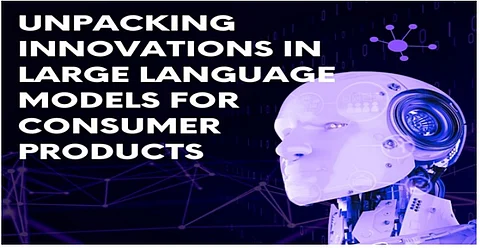

In the fast-changing world of artificial intelligence, Large Language Models (LLMs) are a game-changer in determining the future of consumer-facing products. In an eye-opening analysis of the increasing power of AI, USA-based software engineer Rajeshkumar Rajubhai Golani discusses the real-world applications of LLM integration in retail, healthcare, and more. His article brings out the dilemma companies have in deciding between fine-tuning and immediate engineering in the optimization of AI performance in consumer products.
Large Language Models are revolutionizing how companies interact with their customers. These natural language processing superstar AI systems are being incorporated into products such as virtual assistants, content generation tools, and customized recommendation engines. LLMs have grown highly versatile in the last few years, mapping a variety of tasks without extensive task-specific training. With their capacity to comprehend and produce human-like text, LLMs are rendering interactions more natural and responsive, improving user experiences while fueling operational efficiencies.
Fine-tuning is one of the fundamental methods for customizing LLMs to particular consumer product use cases. Through the process of training an already-trained model on industry-specific data, fine-tuning permits exact adjustment for the individualized requirements of fields such as health care, law firms, and finance. This procedure allows LLMs to absorb specialized vocabulary, context, and modes of reasoning, offering increased insight into specialized subjects. The advantage is obvious: more precise, relevant outputs for such specialized tasks as legal document review or medical diagnosis, which involve high specificity and domain expertise. Yet fine-tuning requires enormous computational power and human expertise, rendering it a more resource-heavy approach than other methods.
Beneath the surface, prompt engineering is a more exciting and accessible avenue of LLM integration to explore. Rather than customizing the underlying model, prompt engineering is the practice of designing targeted instructions (i.e. This approach is especially appealing to companies that want a faster, cheaper way to adopt AI into their applications. This flexibility in prompt engineering makes it possible to iterate and pivot quickly, allowing companies to adjust AI behavior by changing the prompt instead of needing to retrain the model. This rapid responsiveness to change is priceless in fast-paced markets, enabling companies to test and iterate their offerings in real-time according to user feedback and behavior.
As the LLM ecosystem matures, more enterprises are looking to go beyond the fine-tuning vs prompt engineering dichotomy. Hybrid strategies that blend the best of both approaches are rapidly gaining popularity as organizations aim to achieve optimal balance between performance, cost and operational flexibility. To take an example, an enterprise could prompt engineer the model for basic functions and fine-tune it for more specific activities that need a stronger expertise in domain knowledge. This kind of hybrid model allows companies to get the best of their AI solutions without incurring the cost or complication of having fully fine-tuned models in every aspect of their product suite. Look for more hybrid solutions. As AI tech continues to improve, enterprises are leaning more toward hybrid solutions to meet broad and targeted needs.
To date, one of the most promising innovations in hybrid LLM strategies has been Retrieval-Augmented Generation (RAG). RAG takes the accuracy powered by prompt engineering and external knowledge retrieval, enabling more accurate domain-specific results without retraining a large language model from scratch. This unique architecture improves performance of LLMs by including data from the outside world, in real time, within the generation of an AI’s response, eliminating hallucinations and keeping outputs contextually accurate and timely. By supplementing prompts with data retrieved from external knowledge bases, RAG systems help organizations remain up-to-date without the costly upkeep efforts of fine-tuning. This strategy is especially effective in fast-moving industries where the most current expertise is essential, like customer service or e-commerce.
From a cost perspective, the long-term scalability potential makes fine-tuning a better choice over prompt engineering alone. Though fine-tuning remains the gold standard for high accuracy on specialized tasks, it is resource-heavy, requiring high-performance computing infrastructure and domain-specific training datasets. This concept becomes a far more pricey solution, especially for smaller organizations or ones who are new to dabbling in the space of AI. Prompt engineering offers a much lower barrier to entry for resource-strapped businesses. This speed to iterate and test new ideas with pre-existing models is what makes prompt engineering such an attractive fit for startups or companies in the nascent stages of product development.
Both prompt engineering and fine-tuning have a common problem, which is the need for constant tuning. LLMs, like any other AI model, require constant updates to maintain their effectiveness as business needs and external conditions evolve. Fine-tuned models can need to be retrained periodically to include new data, whereas prompt engineering methods need to adjust to changes in user behavior and language usage. Companies have to invest in retraining models and prompt fine-tuning to ensure peak performance. The strategic choice between the two methods finally depends on the complexity of the product, adaptation speed, and resources.
So, Rajeshkumar Rajubhai Golani’s article underscores the importance of strategic decision-making when implementing LLMs into consumer products. Regardless of whether choosing fine-tuning, prompt engineering, or a hybrid approach, businesses need to consider their individual needs, growth stage, and resource allocation. As AI is further developed, most successful applications will be those which tie technical strategies to business goals so that LLM-driven products are providing value to customers. By making highly informed choices and making changes based on that, companies can see through the niceties of deploying AI and stay in front in an increasingly competitive marketplace.
